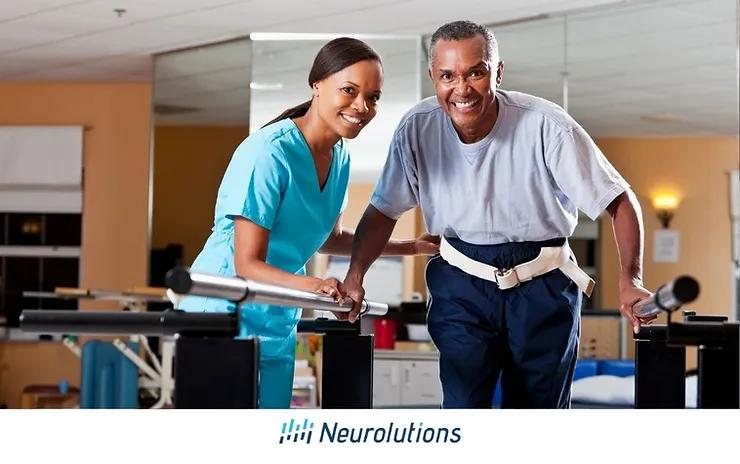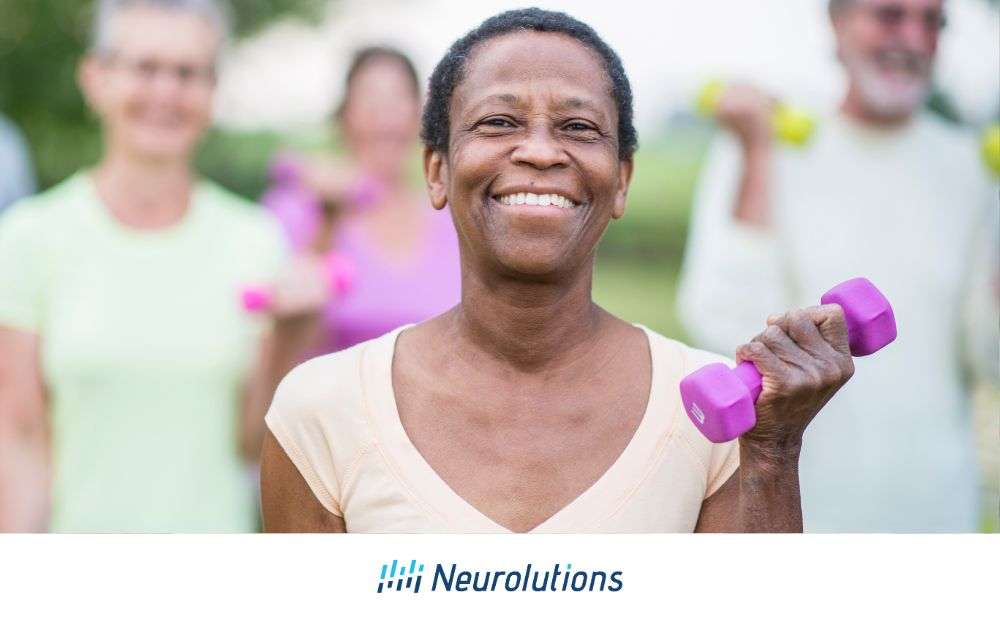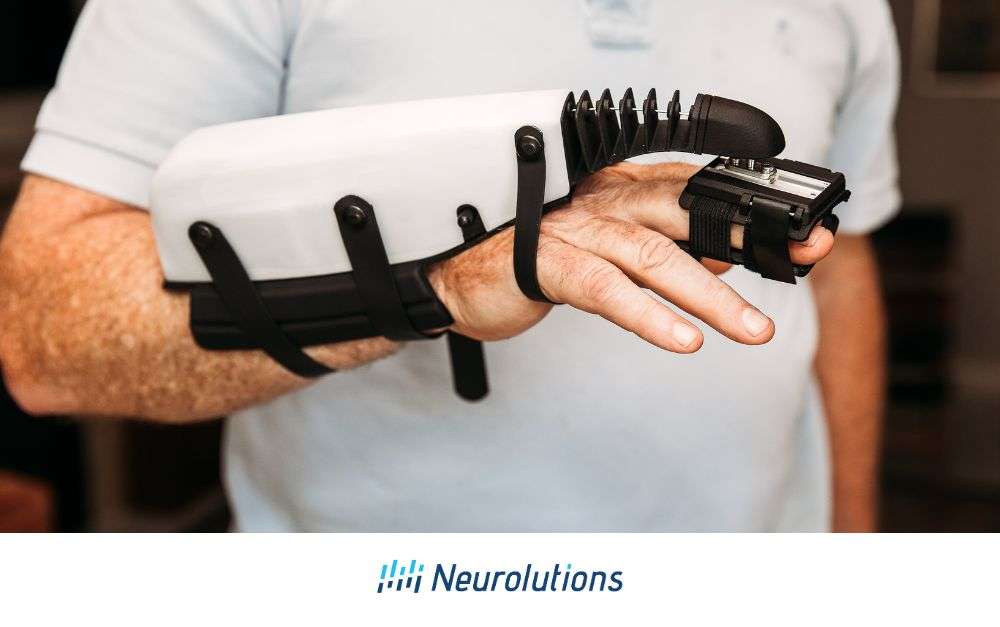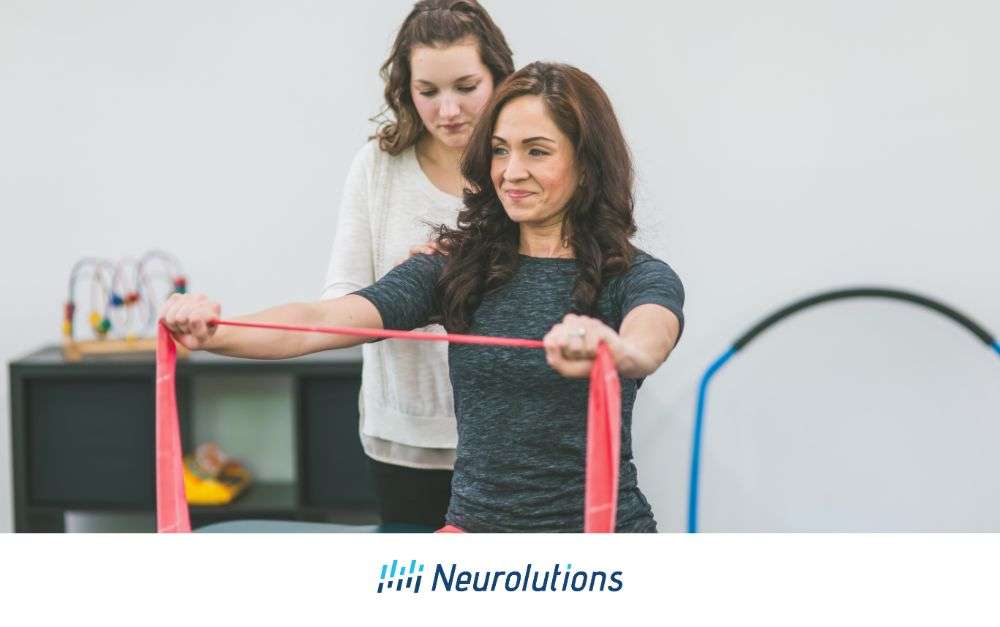Physical and occupational therapists often employ a variety of approaches when treating a stroke survivor to recover their motor skills. The Brunnstrom Approach, developed by Swedish physical therapist Signe Brunnstrom in the 1960s, is a widely recognized and influential approach in stroke rehabilitation. It focuses on understanding and facilitating the natural progression of motor recovery. The Brunnstrom approach can also be used for evaluating motor skills prior to and during therapy to assess progress toward full recovery (1). It is important to note that this approach is not typically taught and practiced as commonly anymore.
By understanding the Brunnstrom stages of stroke recovery, stroke survivors and their families will have a clearer understanding of what to expect during the recovery process. Knowing that recovery typically progresses through stages can reduce patients’ anxiety and frustration by setting realistic expectations for improvement over time.
The seven Brunnstrom stages are described below, each with corresponding examples of therapeutic exercises. Common consequences that impact motor skill recovery following stroke are also discussed.
What are the Brunnstrom Stages of Stroke Recovery?
It should be noted that while the Brunnstrom stages provide a general framework for understanding the progression of motor recovery after a stroke, not all individuals will follow a sequential order as they move through these stages during physical therapy (PT) and occupational therapy (OT) stroke rehabilitation.
The progression through the Brunnstrom stages can vary widely from person to person, and it’s important for healthcare professionals to recognize and accommodate individual differences. Moreover, the National Institutes of Health (NIH) states that starting a PT/OT program within the first 2-3 months following a stroke is preferable, as delaying these therapies generally doesn’t yield as successful rehabilitation outcomes for the stroke survivor’s motor skills (2).
The seven Brunnstrom stages of stroke recovery are (3):
- Stage 1: Flaccidity Stage
- Stage 2: Spasticity Appears
- Stage 3: Increased Spasticity
- Stage 4: Decreased Spasticity
- Stage 5: Complex Movement Combinations
- Stage 6: Spasticity Disappears
- Stage 7: Normal Function Returns
Muscles of the body are composed of millions of muscle fibers, and nerves enable these fibers to contract and relax. In turn, this enables the muscles themselves to contract, relax, and work seamlessly together to generate movement. Depending upon the severity of brain injury due to stroke, the normal signals sent by the brain to the spinal cord and on to the muscle fibers can become negatively affected. This joint-muscle activity, or synergy, that occurs during any movement is the basis of the seven Brunnstrom stages that guide the patient’s specific rehabilitation plan.

Brunnstrom Stage 1 – Flaccidity Stage
Stage 1 of the Brunnstrom Approach is Flaccidity. Flaccidity is typically characterized by a complete lack of voluntary movement in the affected muscles. Additionally, reflexes and limb sensation may be absent. Individuals in the flaccid stage typically require a high level of assistance with daily activities, as they are unable to move the affected limb to any degree. Because of the lack of muscle tone and movement, there is an increased risk of complications such as j, pressure ulcers (bedsores), and venous thrombosis (blood clots). In order to prevent stiffness and muscle atrophy, the physical or occupational therapist may passively move the body part to preserve its future movement capacity.
The brain is composed of two hemispheres split into left and right, and the opposite side of the body from the injured hemisphere is the one that is typically impacted by paralysis or weakness. Hemiparesis–partial weakness of one side of the body– affects 65% of all people who experience a stroke (4). If nerve impulses no longer reach fibers of the muscles involved, the stroke survivor becomes unable to move the affected limb and consequently cannot utilize it for regular bodily motions.
OT/PT interventions in the Flaccidity Stage aim to provide joint stability , provide sensory stimulation, “wake up” muscles and work the brain.” Interventions may include passive stretching, education on optimal positioning, gentle weight bearing, soft tissue mobilization, sensory re-education, electrical stimulation, and activities to build awareness and integration of the flaccid side into transfer and daily tasks.
It’s important to note that the flaccid stage is an early and often temporary phase of stroke recovery. Over time, with appropriate rehabilitation and therapy, some individuals progress to subsequent stages where they regain some muscle tone, movement, and control over their affected limbs.
Brunnstrom Stage 2 – Spasticity Appears
Stage 2 of the Brunnstrom Approach is characterized by the emergence of spasticity, which is a form of muscle stiffness and increased muscle tone. This stage is often referred to as the “spasticity stage” and is a transitional phase in stroke recovery. Key features of Stage 2 include development of spastic reflexes, lack of volunary control, emergence of basic reflexes, and increased muscle strength.
As the brain injury begins to heal and various nerve impulses to the spinal cord resume, the stroke victim may begin to be able to make small movements such as wiggling some fingers or slightly lifting a leg. However, not all muscle fibers during these stages are necessarily receiving sufficient instructions, which leads to the development of spasticity. For example, a movement of the leg to the side might cause it to involuntarily bend at the knee. Likewise, moving the hand at the wrist may cause the fingers to flex or curl. While the stroke survivor may be pleased with simply being able to move the hand again, the spasticity of the fingers may make holding an object impossible at this point.
It’s important to note that Stage 2 represents a phase of transition, and the ultimate goal of rehabilitation during this stage is to gradually reduce spasticity and promote more controlled, purposeful movements. Therapy strategies may include stretching exercises to manage spasticity, passive and active range of motion exercises, and activities that encourage voluntary movements outside of the synergistic patterns.
It is also important to address mindfulness so the individual learns to reduce compensatory movements that promote dysfunctional patterns as well as learn to consciously signal the intention to relax overactive muscles.
Brunnstrom Stage 3 – Increased Spasticity
Stage 3 of the Brunnstrom Approach is defined by the further development of spasticity and the appearance of synergistic patterns of movement. This stage is often referred to as the “voluntary movement stage.” Stage 3 characteristics include further heightening of spasticity, emergence of strong synergistic patterns, emerging motor control, and continued spastic reflexes.
As the ability to move the formerly weak extremity increases, spasticity often increases. Given that heightened anxiety and depression commonly manifest in individuals post-stroke, the escalation of spasticity can contribute to a sense of discouragement towards PT and/or OT. This is not the time to become discouraged.
Stage 3 also represents a period of transition as the individual continues to regain motor control and function. The goal of therapy during this stage is to build on emerging voluntary movements, gradually reduce the dominance of synergistic patterns, and work toward greater independence in daily activities. As with the previous stages, the timeline for progressing through Stage 3 varies from person to person, and therapy plans are adjusted accordingly to support the individual’s unique journey toward recovery
It is also important to utilize treatment options that counter “learned non-use” of the limb. Constraint-induced movement therapy, repetitive practice of valued tasks, appropriate application of resistance training, assisted-robotic interventions, functional electrical stimulation, use of dynamic orthotics, and non-invasive brain-computer interface, may be an option.
Brunnstrom Stage 4 – Decreased Spasticity
Stage 4 of the Brunnstrom Approach is marked by a decrease in the muscle stiffness and rigidity associated with spasticity. Because the movement skills a person learns in infancy and early childhood, such as walking and self-feeding, can become erased memories due to a stroke, physical/occupational therapists may need to aid their patients to relearn these skills.
As these various physical movements are practiced, the spasticity experienced when holding a cup or spoon up to the mouth for example, can gradually become lessened. In this stage, a therapist might introduce exercises involving more complex movements as well as strength-promoting exercises that require more physical coordination. A stroke survivor will find that sometimes the lessening of their spasticity will increase the future likelihood of their ability to independently perform their usual activities of daily living (ADLs), such as carrying a plate of food to the kitchen table, without injury.
Engaging in a therapeutic exercise program, inclusive of the movements needed to perform routine ADLs, directly following a stroke is crucial for fully eliminating spasticity. As spasticity decreases, the stroke-affected person may begin to undertake PT/OT exercises targeted at significantly increasing joint range of motion. For a person to safely take a walk uphill for aerobic exercise or to visit a friend’s home nearby, a high level of joint range of motion is generally involved.
Brunnstrom Stage 5 – Complex Movement Combinations
Stage 5 of the Brunnstrom Approach is the phase of recovery where joint range of motion increases to a level where the stroke survivor can perform complex movement combinations. This stage marks the point where many middle and senior-aged adults are not only able to perform basic ADLs without giving them much thought, but also engage in complex activities such as climbing a ladder, jogging, or driving a car.
As a component of complex movement combinations, “range of motion” is the term used to describe the level that a person can move a joint to its greatest normal ability. In order to maximize each joint’s flexibility, PT and/or OT sessions for recent stroke survivors typically include a wide range of passive and active range-of-motion exercises. For example, when a person lifts a fork or spoon to eat, different finger and wrist movements are necessary for the fork or spoon to reach the mouth. The complexity of this task can be made progressively more difficult, starting with holding the fork, then attempting rotating the fork to gather food, , then advancing to lifting the fork toward the mouth. In this exercise, practice is key for muscle synergy to bring the fork or spoon to the mouth rather than falling onto the table or floor.
A stroke survivor needs to be able to re-acquire complex movement combinations to more easily perform their routine tasks. Notably, autonomy in performing ADLs is closely linked to experiencing a good quality of life (5). Therefore, re-developing the ability to self-feed, dress/undress, and walk after a stroke is an important goal. Achieving sufficient range of motion in all joints is an aspect of enabling better future independence of action. It is also possible for ADLs to be modified and performed one-handed.
Brunnstrom Stage 6 – Spasticity Disappears and Coordination Increases
During Stage 6 of the Brunnstrom Approach, spasticity disappears in the patient. As a result, they will start to experience muscle group flexibility and synergy, muscle strength, and acquire a functional level of range of motion all to promote increased overall coordination. Stroke survivors often experience clumsiness when carrying out ADLs until their capacity to execute intricate physical movements required for proper coordination becomes restored.
Improving the coordination between the upper and lower extremities becomes a vital focus in this stage, given that accidents and injuries can result from clumsiness during activities such as getting out of bed, walking to the bathroom, and cooking/meal preparation. During the course of PT and/or OT stroke rehabilitation, the therapeutic techniques in the physical and/or occupational therapists’ treatment plan are aimed at eliminating spasticity while also increasing physical coordination.
The goal of Stage 6 is to engage in tasks that require a greater degree of coordination than in the previous stage., the stroke survivor will achieve enough ability to perform normal activities in a safe manner such that program oversight under skilled OT or PT is no longer necessary.
Brunnstrom Stage 7 – Normal Function Returns
Stage 7 of the Brunnstrom Approach occurs when the stroke survivor’s functioning is assessed as either a return to pre-stroke level or possibly even better than prior to the stroke. Although the optimal goal is return to pre-stroke functioning, , other health issues, cognitive and/or behavioral impairments, the location of the stroke, and severity of the stroke can impact the prognosis and likelihood of normal return of functioning .
Daily repetition of range of motion and strength-building exercises as prescribed by the PT and/or OT, as well as repetitive practice of former routine activities, can facilitate functional gains. In turn, this return to a more independent life can boost overall quality of life for the stroke survivor.
Why Do Brunnstrom Stages Matter in Stroke Rehabilitation?
Physical and occupational therapists typically perform a scaled severity assessment on stroke survivors who are their new patients. This is linked to the Brunnstrom Stages and referred to as the Brunnstrom Fugl-Meyer Assessment Test (6). This approach allows for personalized PT and/or OT treatment strategizing that centers around the unique situation and requirements of the stroke survivor. While certain individuals might have led relatively inactive lifestyles prior to their stroke, others could have had an active lifestyle or maintained regular fitness routines. Furthermore, re-assessments on post-stroke patients are performed regularly in order for the therapist to measure progress over time, as well as aid in predicting stroke recovery outcomes.
By occasionally reassessing and adjusting the treatment plan, exercises, ADLs, and repetition frequency can be tailored to better meet the actual needs of the specific stroke patient. The importance of the seven stages for stroke patients, family members, friends, and personal health aids is that realistic expectations can be promoted. This, in turn, improves the motivation to participate in the exercise regimen.
For a stroke survivor with a moderate-to-severe stroke, PT and/or OT sessions can still help them compensate for permanently lost motor skills in order to live as independently as possible. Furthermore, promoting optimism and an overall positive outlook can enhance motivation in stroke patients who are experiencing dwindling enthusiasm for PT/OT as a consequence of a loss of motor skills and independence.
Integrating Therapeutic Techniques with Brunnstrom Stages for Stroke Rehabilitation
Targeted recovery outcomes inform the individualized exercise regimens that physical and occupational therapists create for stroke survivors. Therapeutic techniques can be passive, including massage, electrical stimulation of limbs, and range-of-motion exercises while active-assisted exercises can include throwing a beach ball toward the patient to catch it.
For a stroke survivor experiencing weakness in a hand, lifting light weights that are switched to progressively heavier weights over time can be incorporated into the treatment plan to increase hand strength. Practicing finger dexterity by typing on a manual typewriter or pressing buttons on a gameboard may be used in some patients, while utilizing typical fitness center equipment may be used in treating others. Physical and occupational therapists usually attempt to create a treatment plan that incorporates exercises related to activities the stroke survivor enjoys.
The Relationship of Cognitive Impacts of Stroke on Therapeutic Techniques and Return to Independent Functioning
In addition to short-term memory challenges, impaired decision-making and problem-solving can affect the recovery of physical function of the extremities. Not only may a stroke survivor be unable to perform specific exercises and activities without the input of the physical or occupational therapist, but a person recovering from a stroke may not recognize that carrying a heavy object with a weak hand and/or spasticity can result in dropping the object.
Therefore, the utilization of Brunnstrom stages as both an assessment tool and a treatment planning guide can help the person who has experienced a stroke to understand what activities they can safely perform independently at each stage of their recovery.
Exploring Brunnstrom Stages: What Are Their Limitations?
The primary focus of the seven Brunnstrom stages is on the advancement of motor skills, rather than the psychological impacts of a stroke that can make the survivor feel too overwhelmed to concentrate on honing the essential skills for regaining complete independence. The early period of recovery from stroke is often featured by periodic and intense fatigue, which can interfere with performing the PT and/or OT exercise and activity regimen at a level that is optimal for a complete return to pre-stroke functioning.
Changed Historical Nomenclature for Brunnstrom Stages
Signe Brunnstrom originally described six stages of stroke recovery (7). In light of increased neurophysiological knowledge, a seventh stage – normal function returns – was added by Brunnstrom in the 1970s (8). The addition of this seventh stage was aligned with a recognition that complete recovery of motor skills may not actually equate to a return to normal functioning. For example, a stroke survivor may fully recover all of the motor skills needed to drive an automobile, but still not possess the reflexive speed needed to avoid a car accident. Therefore, achieving the seventh stage of recovery would be necessary for that individual to be able to resume safe driving.
There is more than one naming convention (nomenclature) used for each of the seven Brunnstrom stages in physical therapist training curricula and educational materials, as well as blogs, but the description of each individual stage remains the same. Therefore, you may read slightly differently wording of the title of each individual stage, depending upon the blog article, peer-reviewed medical journal article, or textbook (9-10).
Empowering Stroke Recovery through Brunnstrom Stages
The Brunnstrom stages can serve as a guide for stroke survivors and health professionals alike in regaining the motor skills necessary for self-bathing, using a cell phone to interact with family members and friends, and other routine tasks. Ultimately, it can enable both stroke survivors and health professionals to understand what a stroke recovery treatment plan should entail so that people who have experienced strokes can receive individualized treatment that will foster an improved quality of life. It is important to note again that this approach is not typically taught and practiced as a commonly anymore. Many stroke survivors are able to recover or even exceed their pre-stroke level of motor skills when PT and/pr OT is incorporated quickly and sustained for the number of sessions that is necessary for a full recovery.
References:
1. Ottosson A. (2021). Signe Brunnström’s Influence on US Physical Therapy. Physical Therapy 101(8): pzab156. Webpage: https://academic.oup.com/ptj/article/101/8/pzab156/6359587
2. National Institutes of Health (NIH) [NIH Research Matters]. (September 28, 2021). Critical time window for rehabilitation after a stroke. Webpage: https://www.nih.gov/news-events/nih-research-matters/critical-time-window-rehabilitation-after-stroke
3. Flint Rehab. (May 5, 2023). Flaccidity After Stroke: What to Look for & How to Recover. Webpage: https://www.flintrehab.com/flaccidity-after-stroke/
4. Wist S, Clivaz J, and Sattelmayer M. (2016). Muscle strengthening for hemiparesis after stroke: A meta-analysis. Annals of Physical and Rehabilitation Medicine 59(2): 114-124. Webpage: https://www.sciencedirect.com/science/article/pii/S187706571600035X#:~:text=After%20a%20stroke%2C%20hemiparesis%20is,of%20stroke%20victims%20%5B3%5D.
5. van Leeuwen KM, van Loon MS, van Nes FA, et al. (2019). What does quality of life mean to older adults? A thematic synthesis. PLoS One 14(3): e0213263. Webpage: https://www.ncbi.nlm.nih.gov/pmc/articles/PMC6407786/
6. Crow JL, and Harmeling-van der Wel BC. (2008). Hierarchical properties of the motor function sections of the Fugl-Meyer Assessment Scale for people after stroke: A retrospective study. Physical Therapy 88(12): 1554-1567. Webpage: https://academic.oup.com/ptj/article/88/12/1554/2742223
7. Kaushik H. (n.d.) Brunnstrom’s Approach. [PowerPoint Presentation] Webpage: https://www.physio-pedia.com/images/5/5b/Brunnstrom’s_Approach.pdf
8. Sawner KA and LaVigne JM. (1992). Brunnstrom’s Movement Therapy in Hemiplegia: A Neurophysiological Approach. Webpage: https://openlibrary.org/books/OL1553675M/Brunnstrom%27s_movement_therapy_in_hemiplegia
9. Stroke. Chapter 3 – Lower Extremity. In: Stroke Rehabilitation Handbook 2020; pp. 2. Webpage: http://www.ebrsr.com/sites/default/files/Chapter%203_Lower%20Extremity_2020_ML.pdf
10. Gowland et al. (1993). Chedoke-McMaster Stroke Assessment: Development, Validation and Administration Manual. In: Chapter 7. Scoring and Interpreting the Chedoke Assessment. Table 7.1.; pp. 7-6. Webpage: http://www.ebrsr.com/sites/default/files/Chapter%203_Lower%20Extremity_2020_ML.pdf





